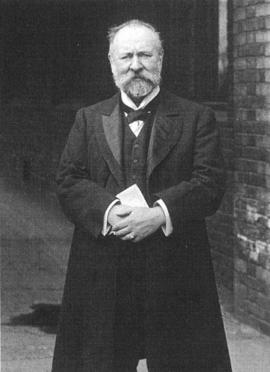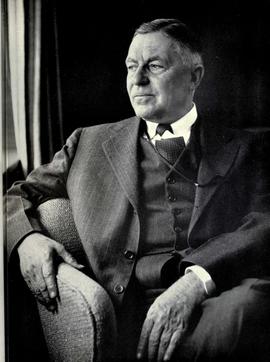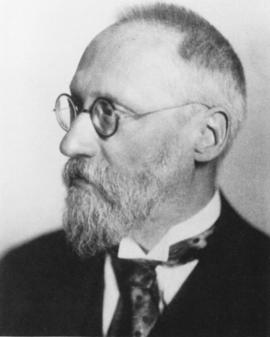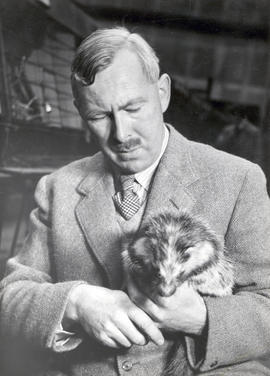Richard Bowdler Sharpe was an English zoologist and ornithologist who worked as curator of the bird collection at the British Museum of Natural History. In the course of his career he published several monographs on bird groups and produced a multi-volume catalogue of the specimens in the collection of the museum. He described many new species of bird and also has had species named in his honour by other ornithologists including Sharpe's longclaw (macronyx sharpei) and Sharpe's starling (poeopters sharpii). He was Clerk in Charge of the Library at the Zoological Society of London 1867-1872. Sharpe founded the British Ornithologists' Club in 1882 and edited its bulletin. He was a Fellow of the Zoological Society of London and the Linnean Society
Sir Terence Charles Stuart Morrison-Scott was a British zoologist who was Director of the Science Museum and the British Museum (Natural History) in London. He was appointed as an Assistant Keeper (2nd class) in the Department of Zoology at the British Museum (Natural History) in 1936. He was promoted to Assistant Keeper (1st class) in 1943. He became Head of the Mammal Section in 1945 and Principal Scientific Officer in 1948. From 1956-1960 he was Director of the Science Museum. Then from 1960 he was Director of the British Museum (Natural History) until his retirement in 1968. He was Honorary Treasurer of the Zoological Society of London 1950-1976.
Karl Max Schneider was an East German zoologist who served as director of the Leipzig Zoo from 1934 until his death. He was an expert on lions and their biology and was responsible for coining the behavioural term 'flehmen'
Gladwyn Kingsley Noble was an American zoologist who served as the head curator for the Department of Herpetology and the Department of Experimental Biology at the American Museum of Natural History. Noble is the taxon author of 20 new species of reptiles. A species of lizard, Anolis noblei, is named in his honour. Also, a subspecies of lizard, Sphaerodactylus darlingtoni noblei, is named in his honor
Alexander Grant Ruthven received a PhD in zoology from the University of Michigan in 1906. He worked as a professor, director of the University Museum, and Dean. He became the President in 1929. The work of Ruthven on the familiar garter snakes, published in 1908, may be regarded as founding an essentially new school of herpetology in the United States. Ruthven described and named 16 new species of reptiles. Ruthven is commemorated in the scientific names of seven reptiles: Geophis ruthveni, Holbrookia maculata ruthveni, Lampropeltis ruthveni, Lepidoblepharis ruthveni, Macropholidus ruthveni, Masticophis schotti ruthveni, and Pituophis ruthveni
Franz Werner was an Austrian zoologist and explorer. Specialising as a herpetologist and entomologist, Werner described numerous species and other taxa of frogs, snakes, insects and other organisms
Otto von Wettstein, name also given as Otto Wettstein-Westersheimb, was an Austrian Zoologist. He was the son of botanist Richard Wettstein and the brother of botanist Fritz von Wettstein. He is best known for his work in the field of herpetology
George Soper Cansdale was born in Brentwood, Essex and attended Brentwood School before studying for a degree in forestry at St Edmund Hall, Oxford. He then joined the Colonial Service, and in 1934 was appointed as Forestry Officer for the Gold Coast (now Ghana), where he started collecting animals for a friend who worked at Paignton Zoo. He used local children to help him collect specimens, and as a result discovered several new species. He began supplying animals for several zoos, including London Zoo.
In 1947 he was recruited by the Zoological Society of London as their Superintendent, a post which he held until 1953. During that period he began to broadcast for the BBC, on early wildlife programmes such as 'Heads, Tails and Feet', 'Looking at Animals' and 'All About Animals', the latter two of which won the Royal Television Society's silver medal in 1952. He also made regular appearances on Children's Hour on BBC radio. From the 1960s onwards he was a regular guest on Blue Peter.
In the 1960s Cansdale became Director of Marine Land in Morecambe, Chessington Zoo and Natureland in Skegness. He also developed, with his son, a method of obtaining clean seawater by filtering it through beach sand, and set up a company, SWF Filtration Ltd, which won the international IBM Award for Sustainable Development in 1990.
His books included 'Animals in West Africa' (1946), 'Animals and Man' (1952), 'George Cansdale's Zoo Book' (1953), 'Belinda and the Bushbaby' (written with his wife, 1953), 'Reptiles of West Africa' (1955), 'The Ladybird Book of British Wild Animals' (1958), 'West African Snakes' (1961), 'Behind the Scenes at a Zoo (1965) and 'Animals of Bible Lands' (1965).
Bennett was an English Zoologist and writer. He was the elder brother of the botanist John Joseph Bennett. He was born at Hackney and practiced as a surgeon, but his chief pursuit was always zoology. In 1822 he attempted to establish an entomological society, which later became a zoological society in connection with the Linnean Society. This in turn became the starting point of the Zoological Society of London, of which Bennett was Secretary from 1831-1836.
His works included 'The Tower Menagerie' (1829) and 'The Gardens and Menagerie of the Zoological Society (1831). He also wrote, in conjunction with G. T. Lay, the section of Fishes in the 'Zoology of Beechey's Voyage' (1839). In 1835 he described a new species of African crocodile, Mecistops leptorhynchus, the validity of which was confirmed in 2018.
Baird was a Scottish Zoologist and physician. He was best known for his 1850 work, The Natural History of British Entomostraca.
Baird studied at the High School of Edinburgh, before studying medicine at the universities of Edinburgh, Dublin and Paris. He was a surgeon for the East India Company from 1823 to 1833, travelling to India, China and other countries, and taking a keen interest in those countries' natural history. He helped found the Berwickshire Naturalists' Club in 1829. Baird practiced as a doctor in London until 1841, when he joined the zoology department of the British Museum (Natural History).



